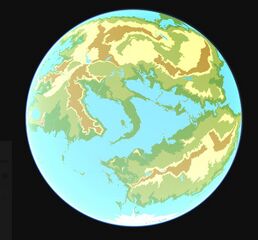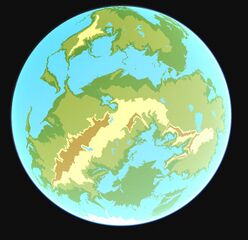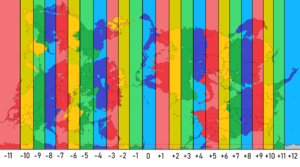Iearth: Difference between revisions
| Line 95: | Line 95: | ||
About 50% of Iearth is covered in water, with the remainder of of land also being roughly 90% uninhabitable due to mountains, desert, and ice caps. The northernmost permanently inhabited place in the world, at latitude 82°30'05" north, 817 kilometres (508 mi) from the North Pole, located at [[Recon Percilius Joint Research Station]] on [[Percilius Jacobeir Island]] in [[New Anea]] on the continent of [[Nortua]]. The southernmost is the [[Joint Antartique South Pole Station]] located almost exactly at the South Pole on the continent of [[Antartique]]. | About 50% of Iearth is covered in water, with the remainder of of land also being roughly 90% uninhabitable due to mountains, desert, and ice caps. The northernmost permanently inhabited place in the world, at latitude 82°30'05" north, 817 kilometres (508 mi) from the North Pole, located at [[Recon Percilius Joint Research Station]] on [[Percilius Jacobeir Island]] in [[New Anea]] on the continent of [[Nortua]]. The southernmost is the [[Joint Antartique South Pole Station]] located almost exactly at the South Pole on the continent of [[Antartique]]. | ||
Humanity has also extended its reach beyond the planet's surface. The [[Coalition Space Station]] is a scientific module built, maintained, and crewed by an international community of scientists and astronauts that orbits the planet. The [[Marri-1]] launch in June 6th, 1962 put the first humans, [[Zamastan]]ian astronauts [[Casey Giverston]] and [[Demarcus Free]], into space. In 1970, a joint-[[Beleroskov]] and [[Drambenburg]]ian rover was landed on the moon, and on June 3rd, 1972 the Zamastanian [[Blue Falcon 3]] mission put astronauts [[John Bennett]], [[Vincent Steward]], and [[Edward Wood Chambers]] on the lunar surface. The [[Courage program]] is an international effort underway to colonize [[Eirus]], the | Humanity has also extended its reach beyond the planet's surface. The [[Coalition Space Station]] is a scientific module built, maintained, and crewed by an international community of scientists and astronauts that orbits the planet. The [[Marri-1]] launch in June 6th, 1962 put the first humans, [[Zamastan]]ian astronauts [[Casey Giverston]] and [[Demarcus Free]], into space. In 1970, a joint-[[Beleroskov]] and [[Drambenburg]]ian rover was landed on the moon, and on June 3rd, 1972 the Zamastanian [[Blue Falcon 3]] mission put astronauts [[John Bennett]], [[Vincent Steward]], and [[Edward Wood Chambers]] on the lunar surface. The [[Courage program]] is an international effort underway to colonize [[Eirus]], the fourth planet in the solar system. | ||
Humanity has divided the planet into timezones, which are areas that observes a uniform standard time for legal, commercial and social purposes. Time zones tend to follow the boundaries between countries and their subdivisions instead of strictly following longitude, because it is convenient for areas in frequent communication to keep the same time. | Humanity has divided the planet into timezones, which are areas that observes a uniform standard time for legal, commercial and social purposes. Time zones tend to follow the boundaries between countries and their subdivisions instead of strictly following longitude, because it is convenient for areas in frequent communication to keep the same time. | ||
Revision as of 17:14, 31 August 2021
This article is incomplete because it is pending further input from participants, or it is a work-in-progress by one author. Please comment on this article's talk page to share your input, comments and questions. Note: To contribute to this article, you may need to seek help from the author(s) of this page. |
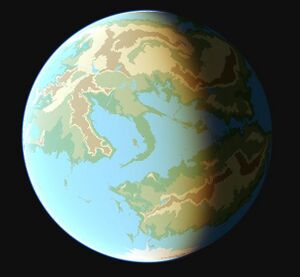 Photographs of Iearth, taken by the Zamastanian Zian-2B Satellite | |
| Orbital characteristics | |
|---|---|
| 149598023 km (92955902 mi; 1.00000102 AU) | |
| Eccentricity | 0.0167086 |
| 365.256363004 d (1.00001742096 yr) | |
| Satellite of | Sun |
| Physical characteristics | |
Mean radius | 6371.0 km (3958.8 mi) |
| 510072000 km2 (196940000 sq mi) | |
| Volume | 1.08321×1012 km3 (2.59876×1011 cu mi) |
| Mass | 5.97237×1024 kg (1.31668×1025 lb) |
Mean density | 5.514 g/cm3 (0.1992 lb/cu in) |
| 9.807 m/s2 (1 g; 32.18 ft/s2) | |
| 11.186 km/s (40270 km/h; 25020 mph) | |
| 23.4392811° | |
| Atmosphere | |
Surface pressure | 1 atm (100 kPa) |
Iearth, also known as Earth or the World, is the fifth planet from the Sun in the Estrella System. It is the only planet in the cosmos known to accomodate life. Scientific analysis generally concludes that Iearth developed over 4 billion years ago. The Iearth rotates around the Sun in 365 and ¼ days, a period commonly accepted as a year.
Humans are the most influential lifeform on Iearth, with their influence being clearly seen on the planet's surface whether with reference to atmospheric composition, land cover, hydrology, light or the transportation and transformation of terrestrial material. The world contains a large variety of nations (some of the most significant being Zamastan, Beleroskov, Vulkaria, Yuan, and Cadair), where the developments of humanity can be seen through the many languages spoken, international organizations such as the Coalition of Crown Albatross, conflicts and warfare such as the World War, and the control and manipulation of other species, energy, and natural resources. According to the latest census date the Iearth is home to about 10 billion human beings.
Etmology
The most commonly accepted Caticeze-English word for Iearth comes from the Verdusian word eorðe, meaning dirt, soil, dry land, and ground.
History
See also: History of Iearth
Physical characteristics
Continents
Iearth has an approx. total area of 131,750,000 km2 (50,870,000 sq mi). The land is divided into five continents. A continent is one of several very large landmasses of the world. Identified by convention rather than any strict criteria, we commonly regard up to four regions as continents. Ordered alphabetically, these continents are:
| Map of the Continents | Name | |
|---|---|---|

|
Adula | |
| Antartique | ||
| Ausiana | ||
| Euronia | ||
| Nortua |
Oceans
Iearth is a blue planet. The presence of water on its surface is unique in the Estrella system. The main bodies of water in the hydrosphere are the oceans.
| Map of the Continents | Name | |
|---|---|---|

|
Northern Ocean | |
| Olympic Ocean | ||
| Samson Ocean | ||
| Toyana Ocean |
Humanity
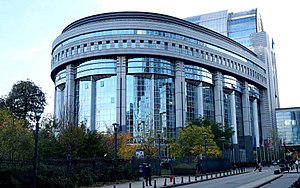
See: List of sovereign states and dependent territories (Iearth)
About 50% of Iearth is covered in water, with the remainder of of land also being roughly 90% uninhabitable due to mountains, desert, and ice caps. The northernmost permanently inhabited place in the world, at latitude 82°30'05" north, 817 kilometres (508 mi) from the North Pole, located at Recon Percilius Joint Research Station on Percilius Jacobeir Island in New Anea on the continent of Nortua. The southernmost is the Joint Antartique South Pole Station located almost exactly at the South Pole on the continent of Antartique.
Humanity has also extended its reach beyond the planet's surface. The Coalition Space Station is a scientific module built, maintained, and crewed by an international community of scientists and astronauts that orbits the planet. The Marri-1 launch in June 6th, 1962 put the first humans, Zamastanian astronauts Casey Giverston and Demarcus Free, into space. In 1970, a joint-Beleroskov and Drambenburgian rover was landed on the moon, and on June 3rd, 1972 the Zamastanian Blue Falcon 3 mission put astronauts John Bennett, Vincent Steward, and Edward Wood Chambers on the lunar surface. The Courage program is an international effort underway to colonize Eirus, the fourth planet in the solar system.
Humanity has divided the planet into timezones, which are areas that observes a uniform standard time for legal, commercial and social purposes. Time zones tend to follow the boundaries between countries and their subdivisions instead of strictly following longitude, because it is convenient for areas in frequent communication to keep the same time.
The planet has resources that have been exploited by humans. Those termed non-renewable resources, such as fossil fuels, are only replenished over geological timescales. Large deposits of fossil fuels are obtained from the planet's crust, consisting of coal, petroleum, and natural gas. These deposits are used by humans both for energy production and as feedstock for chemical production. Mineral ore bodies have also been formed within the crust through a process of ore genesis, resulting from actions of magmatism, erosion, and plate tectonics. These metals and other elements are extracted by mining, a process which often brings environmental and health damage.
